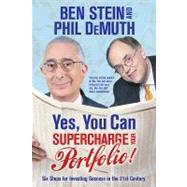
Ben Stein can be seen talking about finance on Fox TV news every week. He has written about finance for Barron’s and The Wall Street Journal for decades and contributes regularly to the AARP’s Modern Maturity (now AARP: The Magazine). He was one of the chief busters of the junk bond frauds of the 1980s, has been a long-time critic of corporate executives’ self-dealing, and has written several self-help books about personal finance.
Phil DeMuth is an investment psychologist with a longstanding interest in the stock market. He has written for The Wall Street Journal and Barron’s, as well as Human Behavior and Psychology Today. His opinions have been quoted on theStreet.com and Fortune Magazine and is president of Conservative Wealth Management in Los Angeles.
| Introduction | p. vii |
| Step 1: Don't Skip Step 1 | p. 1 |
| Step 2: It's Your Whole Portfolio That Matters | p. 7 |
| Step 3: Take on Risk Intelligently | p. 15 |
| Step 4: Diversify | p. 33 |
| Step 5: Use the Monte Carlo Simulator to Test-Drive Your Portfolio | p. 61 |
| Special Topics: A Farewell to Bonds? | p. 93 |
| Special Topics: Roll Your Own Hedge Fund | p. 107 |
| Special Topics: Investing for Income | p. 117 |
| Step 6: Do a Portfolio Reality Check | p. 133 |
| Berkshire Hathaway by Way of Monte Carlo | p. 149 |
| Coping with Concentrated Holdings | p. 153 |
| Glossary | p. 167 |
| Index | |
| About the Authors | |
| Table of Contents provided by Ingram. All Rights Reserved. |
The New copy of this book will include any supplemental materials advertised. Please check the title of the book to determine if it should include any access cards, study guides, lab manuals, CDs, etc.
The Used, Rental and eBook copies of this book are not guaranteed to include any supplemental materials. Typically, only the book itself is included. This is true even if the title states it includes any access cards, study guides, lab manuals, CDs, etc.